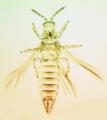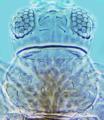Scirtothrips aurantii
Recognition data
Distinguishing features
Both sexes fully winged. Body mainly yellow, with dark brown antecostal ridge on tergites and sternites and small brown area medially; antennal segment I white, II–III pale, V–VIII brown; major setae dark; fore wings pale but clavus shaded. Head wider than long; ocellar triangle and postocular region with closely spaced sculpture lines; 3 pairs of ocellar setae present, pair III close together between anterior margins of hind ocelli; two pairs of major postocular setae present. Antennae 8-segmented; III–IV with forked sensorium. Pronotum with closely spaced sculpture lines; posterior margin with 4 pairs of setae, S2 prominent and about 30 microns long. Metanotal posterior half with irregular longitudinal reticulations; median setae close to anterior margin; no campaniform sensilla. Fore wing first vein with 3 setae on distal half, second vein with 3 widely spaced setae; posteromarginal cilia wavy. Abdominal tergites III – VI median setae small, close together; II–VIII with lateral thirds covered in closely spaced rows of fine microtrichia, these microtrichial fields with three discal setae, posterior margin with fine comb; tergite VIII with comb complete across posterior margin, lateral discal microtrichia extending across middle of tergite; tergite IX with no discal microtrichia. Sternites without discal setae, covered with rows of microtrichia; posterior margins with comb of short microtrichia between marginal setae.
Male smaller than female; tergite IX posterior angles bearing pair of stout curved drepanae extending across tergite X; hind femora with comb-like row of stout setae; sternites without pore plates.
Related and similar species
Within the genus Scirtothrips, the two species S. aurantii and S. dorsalis are unusual in having the abdominal sternites covered with microtrichia. The male of S. aurantii is unique in the genus in the structure of the male hind femur. Scirtothrips currently includes 100 listed species from various parts of the world. Bailey (1964) provided keys to 13 from North America, but that work was based on specimens that were not fully cleared, and thus few structural details were available concerning differences between species. Similarly, Johansen & Mojica-Guzman (1999) provided keys to 33 species from Mexico, but doubts have been expressed concerning the biological reality of many of these (Mound & zur Strassen, 2001). Hoddle & Mound (2003) provided information on 21 Scirtothrips species from Australia, and Rugman-Jones et al. (2006) produced a molecular key to several pest species in this genus. Relationships of various Scirtothrips species based on molecular data are further considered by Hoddle, Heraty et al. (2008).
Taxonomic data
Current valid name
Scirtothrips aurantii Faure
Original name and synonyms
- Scirtothrips aurantii Faure, 1929: 3
- Scirtothrips acaciae Moulton, 1930: 200
Family placement
Thripidae, Thripinae
Common names
South African citrus thrips
Biological data
Life history
Breeding on young tissues of leaves and fruits.
Host plants
Highly polyphagous; recorded from plants in about 30 different families.
Tospoviruses vectored
None
Crop damage
Feeding results in distortion of young leaves, but of greater economic importance is the surface scarring on citrus fruits leading to downgrading of a crop.
Distribution data
Area of origin
South or East Africa
Distribution
Not known from California. Widespread from South Africa to Egypt, also West Africa and Cape Verde Islands; introduced to Queensland, Australia.










